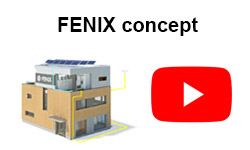An energy concept for the future – put into practice today

It is a characteristic feature of electricity that it is the only form of energy that can be produced from the purest types of renewable resources – i.e. sunlight, wind, and perhaps the movement of sea water. From the aspect of consumption, this isn't a problem at all – it is a versatile kind of energy which can be used just as effectively for cooking as for powering an express train. However, there is one difficulty – electricity cannot be stored easily and we cannot manage its production from renewable resources in a manner that exactly meets our needs, unfortunately. At least so far.
A new concept by FENIX
The combination of energy production from renewable sources in connection with a home battery, electric heating and ventilation, and the “smart grid” could be one answer to the above problem. The properties of batteries are constantly improving with technical development and their price is gradually decreasing. On top of this, batteries offer more solutions. One of them is the construction of island systems – complete or partial – in which users produce electricity themselves, e.g. via photovoltaic solar panels, and only take it from batteries in periods when they really need it. However, energy consumption varies greatly throughout the year, and therefore this solution is demanding as far as the performance of the panels is concerned, as well as the capacity of the batteries. It won't be simple to design the optimum output and capacity for such a system, and this will understandably also be reflected in the acquisition costs.
The second (and more practical) option will be the use of batteries in a shared network. One of the big problems of energy network distribution today is not a lack of electricity but, on the contrary, short-term energy surpluses. Over the past few decades large solar parks have been built in the Czech Republic (and abroad) in great numbers. This has led to distribution networks, at various locations and depending on the weather, being flooded with large doses of electric energy at irregular intervals (and completely without planning). A distribution network can only transmit this energy further with difficulty, and there is a danger of collapse under the strain. However, if there was a sufficiently dense network of users with their own batteries, distributors would certainly be happy to offer an attractive price for energy so that they can use this battery network and thus create something like a "virtual" pumping power station, but with significantly higher energy efficiency than such a plant. This might result in the creation of a new electricity tariff where the electricity distributor would manage the charging of users' batteries via a mass remote control signal in exchange for a low energy price.
It would thus be possible not only to control the period of the charging of batteries for the storage of temporary energy surpluses, but also to switch the building into an autonomous state for a short period during which it wouldn't take any energy from the grid. This mechanism could be used for the easier management of energy peaks. An important advantage of the offered solution is also a significant increase in energy safety and independence.
These issues greatly concern our company as an important European producer of electric heating systems. As there is still very little by way of practical experience in this area, we have decided to construct our own building which makes use of the concept of cooperation between a set of roof-mounted photovoltaic panels and a home battery, an electric heating system and the "smart grid". The purpose is to try out in practice how such a system can be operated in reality, and to see what savings can be achieved with the use of one's own solar “power station”, and to what degree batteries are capable of covering the real operational energy needs of a building.
FENIX administrative building
The test building will be a new administrative building located on the premises of FENIX s.ro. in Jeseník. Its construction should be completed by May 2016. The construction of the building, fully financed by FENIX, will take place under the technical supervision of the Czech Technical University – Microenvironmental and Technical Services Engineering (UCEEB), which will also provide monitoring and evaluation. The Ministry of Industry and Trade, the Ministry of the Environment of the Czech Republic and the Energy Regulatory Office have also sent their experts to the working groups whose task it is to assess the obtained data, and the Chairman of the Board of Directors of ČEPS (the Czech Transmission System Operator) has also shown interest in the information that will be gained from the project.
The building was designed without a cellar, with three floors and a total height of 12m. It has a rectangular floor plan; the dimensions of the built-on area are 10.3 x 14.3 m. The building is designed with a flat roof and will have an insulated reinforced concrete skeleton, with an infill wall made from sand-lime brick. The project design includes direct electric heating, heat recovery ventilation supplemented by cooling and a small photovoltaic power system. It is planned that water will be heated by small storage heaters located at the point of consumption. The building itself is designed as a Nearly-Zero Energy Building (nZEB) and according to Decree No. 78/2013 Coll. has parameters which fulfil the criteria for ranking in class A – extremely economical.
The new administrative centre will contain domestic trade offices, as well as offices used by sales technicians and production managers. In addition there will also be a showroom with FENIX products for visitors, while a conference room for meetings with clients and partners will be situated on the 3rd floor, from which there will be access to a roofed terrace with a garden.
Conclusion
The purpose of the project is to assess the cooperation between a small roof-mounted "solar park" and home batteries and the "smart grid" distribution network, and thereby prove the advantages of this solution to the operators of energy networks as well as users. The idea is to create the conditions for the appearance of a new tariff (buildings with home batteries). This will involve the batteries being charged under advantageous conditions from the grid during periods when there is an energy surplus; at peak periods these batteries will then enable the completely or partially autonomous operation of the building. At the same time, a significantly higher level of energy independence and an important reduction in energy vulnerability should be achieved. The possibility of including this concept in new Ministry of the Environment support programmes will be evaluated.





